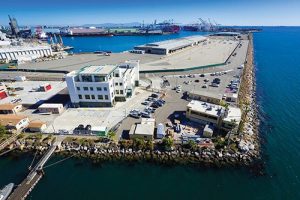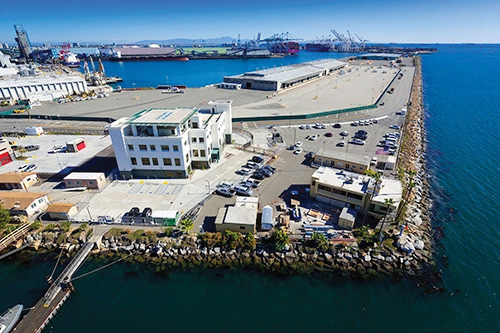
The Port of Long Beach is pursuing a zero-emissions future with a microgrid demonstration project that’s expected to generate a reliable supply of electricity for the port’s main security facility, the Joint Command and Control Center.
Construction began the second week of March on the project, which is aimed at providing energy resilience for the security center while enhancing air quality by delivering clean power for daily operations.
The project would also reduce the POLB’s reliance on diesel generators to produce electricity during outages, according to the port.
“It is vital that we improve energy resilience as we move toward zero-emission equipment that will allow us to enhance air quality while moving a record number of cargo containers,” Port of Long Beach Executive Director Mario Cordero said. “Our move toward large-scale energy resilience in the future will benefit the surrounding communities by taking power demand off the utility grid, especially during extreme heat events when rolling blackouts occur.”
“Generating power with a new microgrid will enhance reliability for the Port’s critical security operations during an outage on the utility grid,” Long Beach Board of Harbor Commissioners President Steven Neal added. “This project also gives us a glimpse into the future and moves us closer toward using greener energy sources.”
Equipped with a 300-kilowatt photovoltaic solar panel array, the microgrid will convert sunlight into electricity for the port’s security headquarters with a connection to provide resilience to Jacobsen Pilot Services, the private company that guides cargo vessels in the port.
The microgrid system’s capability to maintain operations is expected to allow Joint Command and Control Center staff to work uninterrupted during a power outage. The project is anticipated to save the port more than $60,000 annually on electricity costs, with a yearly output of about 520 megawatt hours.
During widespread outages or emergencies, a truck-mounted battery system can remain at the JCCC or serve as a zero-emissions generator that can be deployed to refrigerated container yards, pump stations and other critical areas.
Deploying the microgrid during an outage can reduce the need to use diesel generators for emergency power. Additional features include an energy control center and a 250-kilowatt stationary battery energy storage system.
Port officials say that performance data during the first year of operation will be analyzed and compiled into a report outlining lessons learned, project replication capabilities, and the ability to commercialize microgrid systems. Findings from the demonstration are to be integrated into the port’s design criteria for future marine terminal projects.
Construction of the $12.2 million microgrid is partially funded by a $5 million grant from the California Energy Commission. The project is scheduled to be commissioned this November

